Cullan Hudson's Blog, page 8
July 10, 2015
Ghost Caught on Film?
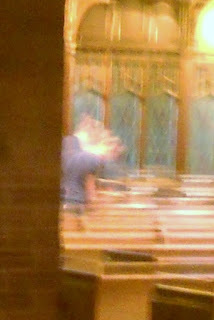
What is seen here in this close up of an empty sanctuary defies explanation.
The image was shot last summer at an old gothic revival church in Oklahoma City. The lighting was too dark for a proper shot of the transept, but the brightly lit sanctuary beyond prevented the flash from firing. This caused the camera to automatically adjust to a slower shutter speed, hence the motion blurring seen here. However, the remarkable thing was the sanctuary was completely vacant at the time.
Blown up, it has the appearance of a woman in a blue, short-sleeve blouse. Upon interviewing church members, it was learned there was once a woman who fit this description at the church. She frequently sat in those pews until she died in the 1980s. Subsequent exploration of the area, the image's EXIF data, and the camera could provide no explanations. No other photos emerged with this anomaly present (and one was taken a scant second later without said figure). An on-location investigation was conducted that brought up some anomalies (pipe smoke in an area where someone who smoked a pipe could be found; the sound of a large group of people talking was heard in the sanctuary as coming from the fellowship hall in the basement, but an investigator in the hall heard nothing; furtive figures glimpsed in choir lofts, etc.)
Published on July 10, 2015 15:04
Gothic Church of the Soul's Dark Night
There is a mournful funeral gathering in a gothic church beneath high vaulted ceilings, stained glass windows and finely crafted wooden paneling and fixtures. The Celtic cross high atop the looming entrance along with its stained glass window, sets the right feel as mourners and casket leave while a stranger utters grim warnings....
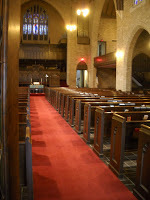 In November of 2005, an Oklahoma City newspaper article informed citizens that a film would need extras for various scenes.Narthax The church, located at NW 25th and Classen Boulevard, had been founded in 1910 as the Wesley Methodist Episcopal Church, North. The impressive pure English Gothic sanctuary with its numerous stained glass windows had been built in 1928. Inside the sanctuary, which is classic cruciform in shape, are hanging lights, classic exposed ceiling beams, over 800 uses of the Gothic arch. The original wood pews, railings and paneling remain and are a dark rich walnut tone.In fact, some members of Wesley did participate as extras playing mourners and mad cult members. Several can be seen in the funeral scene inside the church and then again as they loaded the casket into the hearse at the curb. They remember the experience as very thrilling, intensively fun and very interesting. It was also somewhat controversial with members if the “establishment”. Soul's Midnight(2006) was produced by Brothers Cleveland Productions and Graymark Productions in association with Image Entertainment, with executive producer Gray Frederickson (The Godfather). It was directed by Harry Basil (4th Tenor, Funky Monkey, Fingerprints). The tale of Gothic vampires, ancient ritual cults and supernatural menace was written by Brian Cleveland and Jason Cleveland. Cast included international film star Armand Assante (Odysseus, The Mambo Kings) who is both an Emmy and Golden Globe Award winner. He is also well known as a Global Landmine Activist seeking to remove this danger and save lives.
In November of 2005, an Oklahoma City newspaper article informed citizens that a film would need extras for various scenes.Narthax The church, located at NW 25th and Classen Boulevard, had been founded in 1910 as the Wesley Methodist Episcopal Church, North. The impressive pure English Gothic sanctuary with its numerous stained glass windows had been built in 1928. Inside the sanctuary, which is classic cruciform in shape, are hanging lights, classic exposed ceiling beams, over 800 uses of the Gothic arch. The original wood pews, railings and paneling remain and are a dark rich walnut tone.In fact, some members of Wesley did participate as extras playing mourners and mad cult members. Several can be seen in the funeral scene inside the church and then again as they loaded the casket into the hearse at the curb. They remember the experience as very thrilling, intensively fun and very interesting. It was also somewhat controversial with members if the “establishment”. Soul's Midnight(2006) was produced by Brothers Cleveland Productions and Graymark Productions in association with Image Entertainment, with executive producer Gray Frederickson (The Godfather). It was directed by Harry Basil (4th Tenor, Funky Monkey, Fingerprints). The tale of Gothic vampires, ancient ritual cults and supernatural menace was written by Brian Cleveland and Jason Cleveland. Cast included international film star Armand Assante (Odysseus, The Mambo Kings) who is both an Emmy and Golden Globe Award winner. He is also well known as a Global Landmine Activist seeking to remove this danger and save lives.
 http://film.famousfix.comAlso featured were Robert Floyd (Sliders, Godzilla) , Lucila Sola (Pride and Prejudice) , Miguel Perez ( Ocean’s 11, Blow, Million Dollar Baby), Elizabeth Ann Bennet (Liberty Heights, The Passing) and Joe Nipote (Viper, Casper). Music was supplied by Ceiri Torjussen (The Canal, Scary Movie ii, Devil’s Dozen). As a smaller, independent film it can be entertaining and especially so for anyone with ties to the Oklahoma City and Guthrie areas. Especially, to those with ties to the historic church at NW 25 and Classen. Obviously inspired as much by Anne Rice as Bram Stoker the film is a fun addition to anyone’s collection of vampire films, Oklahoma City films, and the odd and the quirky. Just another in a series of what makes Oklahoma a little strange. See IMDB listing here.
http://film.famousfix.comAlso featured were Robert Floyd (Sliders, Godzilla) , Lucila Sola (Pride and Prejudice) , Miguel Perez ( Ocean’s 11, Blow, Million Dollar Baby), Elizabeth Ann Bennet (Liberty Heights, The Passing) and Joe Nipote (Viper, Casper). Music was supplied by Ceiri Torjussen (The Canal, Scary Movie ii, Devil’s Dozen). As a smaller, independent film it can be entertaining and especially so for anyone with ties to the Oklahoma City and Guthrie areas. Especially, to those with ties to the historic church at NW 25 and Classen. Obviously inspired as much by Anne Rice as Bram Stoker the film is a fun addition to anyone’s collection of vampire films, Oklahoma City films, and the odd and the quirky. Just another in a series of what makes Oklahoma a little strange. See IMDB listing here.
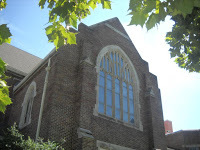
“Company Seeks Extras for Film” Oklahoman (Nov. 4, 2005). “Company Film Next Project in State.” (Nov. 11, 2005). Link to movie Trailer: http://m.youtube.com/watch?v=BlkJ5h92_yg Marilyn A. Hudson, The Windows of Wesley (Whorl Books, 2014). Interviews with extras, June 23-24, 2014 Link to IMDB: http://www.imdb.com/title/tt0493456/ --c Marilyn A. Hudson, 2015
 In November of 2005, an Oklahoma City newspaper article informed citizens that a film would need extras for various scenes.Narthax The church, located at NW 25th and Classen Boulevard, had been founded in 1910 as the Wesley Methodist Episcopal Church, North. The impressive pure English Gothic sanctuary with its numerous stained glass windows had been built in 1928. Inside the sanctuary, which is classic cruciform in shape, are hanging lights, classic exposed ceiling beams, over 800 uses of the Gothic arch. The original wood pews, railings and paneling remain and are a dark rich walnut tone.In fact, some members of Wesley did participate as extras playing mourners and mad cult members. Several can be seen in the funeral scene inside the church and then again as they loaded the casket into the hearse at the curb. They remember the experience as very thrilling, intensively fun and very interesting. It was also somewhat controversial with members if the “establishment”. Soul's Midnight(2006) was produced by Brothers Cleveland Productions and Graymark Productions in association with Image Entertainment, with executive producer Gray Frederickson (The Godfather). It was directed by Harry Basil (4th Tenor, Funky Monkey, Fingerprints). The tale of Gothic vampires, ancient ritual cults and supernatural menace was written by Brian Cleveland and Jason Cleveland. Cast included international film star Armand Assante (Odysseus, The Mambo Kings) who is both an Emmy and Golden Globe Award winner. He is also well known as a Global Landmine Activist seeking to remove this danger and save lives.
In November of 2005, an Oklahoma City newspaper article informed citizens that a film would need extras for various scenes.Narthax The church, located at NW 25th and Classen Boulevard, had been founded in 1910 as the Wesley Methodist Episcopal Church, North. The impressive pure English Gothic sanctuary with its numerous stained glass windows had been built in 1928. Inside the sanctuary, which is classic cruciform in shape, are hanging lights, classic exposed ceiling beams, over 800 uses of the Gothic arch. The original wood pews, railings and paneling remain and are a dark rich walnut tone.In fact, some members of Wesley did participate as extras playing mourners and mad cult members. Several can be seen in the funeral scene inside the church and then again as they loaded the casket into the hearse at the curb. They remember the experience as very thrilling, intensively fun and very interesting. It was also somewhat controversial with members if the “establishment”. Soul's Midnight(2006) was produced by Brothers Cleveland Productions and Graymark Productions in association with Image Entertainment, with executive producer Gray Frederickson (The Godfather). It was directed by Harry Basil (4th Tenor, Funky Monkey, Fingerprints). The tale of Gothic vampires, ancient ritual cults and supernatural menace was written by Brian Cleveland and Jason Cleveland. Cast included international film star Armand Assante (Odysseus, The Mambo Kings) who is both an Emmy and Golden Globe Award winner. He is also well known as a Global Landmine Activist seeking to remove this danger and save lives.
 http://film.famousfix.comAlso featured were Robert Floyd (Sliders, Godzilla) , Lucila Sola (Pride and Prejudice) , Miguel Perez ( Ocean’s 11, Blow, Million Dollar Baby), Elizabeth Ann Bennet (Liberty Heights, The Passing) and Joe Nipote (Viper, Casper). Music was supplied by Ceiri Torjussen (The Canal, Scary Movie ii, Devil’s Dozen). As a smaller, independent film it can be entertaining and especially so for anyone with ties to the Oklahoma City and Guthrie areas. Especially, to those with ties to the historic church at NW 25 and Classen. Obviously inspired as much by Anne Rice as Bram Stoker the film is a fun addition to anyone’s collection of vampire films, Oklahoma City films, and the odd and the quirky. Just another in a series of what makes Oklahoma a little strange. See IMDB listing here.
http://film.famousfix.comAlso featured were Robert Floyd (Sliders, Godzilla) , Lucila Sola (Pride and Prejudice) , Miguel Perez ( Ocean’s 11, Blow, Million Dollar Baby), Elizabeth Ann Bennet (Liberty Heights, The Passing) and Joe Nipote (Viper, Casper). Music was supplied by Ceiri Torjussen (The Canal, Scary Movie ii, Devil’s Dozen). As a smaller, independent film it can be entertaining and especially so for anyone with ties to the Oklahoma City and Guthrie areas. Especially, to those with ties to the historic church at NW 25 and Classen. Obviously inspired as much by Anne Rice as Bram Stoker the film is a fun addition to anyone’s collection of vampire films, Oklahoma City films, and the odd and the quirky. Just another in a series of what makes Oklahoma a little strange. See IMDB listing here.

“Company Seeks Extras for Film” Oklahoman (Nov. 4, 2005). “Company Film Next Project in State.” (Nov. 11, 2005). Link to movie Trailer: http://m.youtube.com/watch?v=BlkJ5h92_yg Marilyn A. Hudson, The Windows of Wesley (Whorl Books, 2014). Interviews with extras, June 23-24, 2014 Link to IMDB: http://www.imdb.com/title/tt0493456/ --c Marilyn A. Hudson, 2015
Published on July 10, 2015 14:08
June 26, 2015
European Bigfoot? Neanderthal legends?
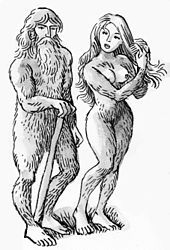 Artist's depiction of a basajaun and its female companion, a basandere.
Artist's depiction of a basajaun and its female companion, a basandere.In Basque mythology, Basajaun (plural: basajaunak) is a huge, hairy hominid dwelling in the woods. They were thought to build megaliths, protect flocks of livestock, and teach skills such as agriculture and ironworking to humans. ---- Wikipedia
Published on June 26, 2015 15:33
June 23, 2015
Sinister Summer Travels: Texas Missions
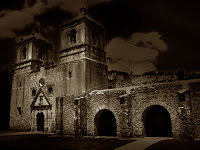 When one thinks of colonial Spanish missions, we often picture those famous churches and presidios of California, but truth is the Spanish had missions all over New Spain. Many of these were located in the vast expanse of present-day Texas, not the least of which is Misión San Antonio de Valero (aka The Alamo).
When one thinks of colonial Spanish missions, we often picture those famous churches and presidios of California, but truth is the Spanish had missions all over New Spain. Many of these were located in the vast expanse of present-day Texas, not the least of which is Misión San Antonio de Valero (aka The Alamo).If you're road-tripping through Texas this summer, you'll find a number of these extant missions to also be delightfully haunted.
Mision San Antonio de Valero (The Alamo)- San Antonio, TX - Est. 1718. Phantom re-enactments of the famous Battle at the Alamo occur as well as soldiers, emerging from the walls at night. Ghostly monks have been witnessed as well. A nightly watch of the walls where the ghosts were said to emerge was conducted with no noticeable activity.
Trailing south of San Antonio are four 18th-century missions legend says are haunted. Mission San Jose has tales of an oft-headless priest, while a creature resembling a wolf and a disquiet native american man have been spotted at San Francisco de la Espada. Another native man has been seen at San Juan de Capistrano. At Mission Nuestra Señora de la Purísima Concepción de Acuña, the least restored of the four, phantom soldiers have been spotted and heard from time to time.
Presidio Nuestra Señora de Loreto de la Bahía, has seen six wars and countless battles. Spanish, Mexican and Texas soldiers are all claimed to still walk within the stone walls of this fortified mission at the heart of Goliad. Some were executed by Antonio Lopez de Santa Anna on Palm Sunday 1836. Other apparitions include a short priest who seems to shuffle listlessly about the churchyard. Others have reported spotting the ghost of a young woman praying in the chapel.
These are just a sampling of the many missions established in Texas between 1689 and 1789. Many of these may be haunted, but finding their stories can be harder. If you visit any of these extant missions (or even the archaeological ruins of those long-gone), be sure to ask about the haunted history. I would love to hear what stories you might uncover.
Published on June 23, 2015 06:38
June 18, 2015
Sinister Summer Travels: Florida
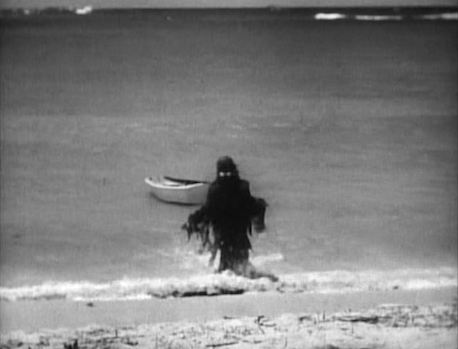 It's summer! For many, this means cookouts, pool time, and vacations. If you're hitting the road or jetting about this summer, here are some dark destinations for when you need a break from are-we-there-yets and the endless queues and din of theme parks...
It's summer! For many, this means cookouts, pool time, and vacations. If you're hitting the road or jetting about this summer, here are some dark destinations for when you need a break from are-we-there-yets and the endless queues and din of theme parks...Florida may be the Sunshine State, but that just means it casts a lot of shadows. Visitors to Bradenton Beach report witnessing some of these shadows walking along the beach around sunset near the Curry House, which was built in 1901 and then torn down in 2004. The stretch of sand nearby, however, still seems permeated with disquiet souls like a woman who appears to have drowned as well as a young boy and his dog.
That state's famous Key West purportedly gains its name from a misunderstanding. Originally, the Spanish called the isle Cayo Hueso (Bone Key) for the many bones they found there. It seems the pre-Columbian Calusa people used the isle as a graveyard. Upon this supernaturally saturated soil, centuries of violence and tragedy have accumulated like barnacles on the hull of a derelict ship. A ghostly figure stalks the building now housing Key West's Hard Rock Cafe; a mysterious, demon-possessed doll hangs about the East Martello museum; and the oldest bar in America, Captain Tony's, was the site of a mass hanging (75 people).
Daytona Beach's Boot Hill Saloon is rumored to be haunted by the disquiet souls of the many bikers who called the bar home over the years. Objects move by themselves and an unplugged jukebox has played tunes.
Now a realty office, the Longwood Village Inn first opened its doors in 1923. Many believe it to be haunted by the ghost of its original owner who died there. Cold spots let you know he is near. The spectral giggles of ghost children have been heard time and again as well.
In Rockledge, a restaurant called Ashley's is rumored to be haunted by a woman named Ethel Allen who was murdered and dumped nearby on the shores of the Indian river in 1934. She is thought to have been an employee when the establishment was known as Jack's Tavern. Witnesses describe hearing a woman's soft, whispered voice when the restaurant is empty. Objects placed in one location upon closing will be found to have moved by the next morning.
Tampa's Ybor City neighborhood is the location of the storied Cuban Club where elevators move of their own accord and a piano can be heard tinkling with no player seen. The nearby Tampa Theatre has been known to show movies when the building is closed.
The former Ringling Estate in Sarasota, FL is haunted by an entire sideshow of spooks. Now a school for art and design, many students have spotted a flapper-era woman, dubbed Mary, glaring at them from a second storey window in what was once a famous hotel. The legend says Mary fell for a traveling salesman who wanted nothing to do with her. In her despair, she hanged herself from the stair rail on the second floor.
St. Augustine's famously haunted lighthouse shouldn't be missed either. The ghosts include, its chief architect, one of its keepers, and the two young daughters of Hesekiah Pity, a keeper from the 1800s.
Clermont, in the shadow of Disney World, is home to the Harden House (486 W
Osceola Street), named for Jown W. Harden who was murdered in his backyard in 1975. The killer was never caught, and some say Harden has never left. Even his own wife claimed to have seen him roaming the house.
Interstate 4, where it crosses Lake Monroe, is said to be cursed. Over 2,000 accidents have occurred here since 1963 and many blame it on a legend that several graves were paved over to make the road. Moreover, ghostly motorcyclists have been spotted as well.
In Ocklawaha, you can find Ma Barker's house. The notorious outlaw and her equally villainous son were gunned down by the FBI in 1935. It's believed that she walks there still.
Published on June 18, 2015 06:48
May 10, 2015
The Mysterious Case of a Disappearing Town (and the mystery of it showing up in my inbox)
So, my mom was cleaning out her inbox (a Herculean task no doubt) and kept finding interesting little e-mails with links to articles on strange phenomena or snippets of dialogue or nascent story ideas that she would pass on to me in hopes they would manifest into something like a good Strange State post. One that caught my eye was about a disappearing town. I was intrigued, but as I began reading it I got the sense that I was reading fiction. But it was really good fiction. She thought perhaps I had written it, but it's not mine. She has no clue where it came from or who wrote it. Who knows? Maybe she wrote it and forgot all about it. I'm going to share it with you now because, though rough in spots, it's got an eerie Lovecraftian style and a cool premise.....
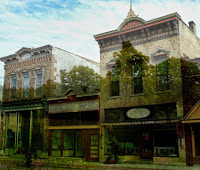
One recalls the town of Urkhammer, Iowa, during the 1920s and early '30s. For years people passed by the bustling burg of Urkhammer without giving it a second thought. Many people even drove through it, and there are rumors that transactions took place between tourists and the pale, mute Urkhammerovians. In 1928 the first ontological doubts about the town began when aerial photographs showed only empty fields where there should have been homes and streets and stores surrounded by farms and waving fields of grain. A week or so later a lost tourist had his Marmot Speedster topped off with gasoline at the Urkhammer Esso station, then, two miles beyond the town's borders, discovered that his tank was empty. He walked back to demand a refund from the conniving general store and gas pump emporium, only to discover that, regardless of how far he walked, the town remained the same distance ahead of him. Fortunately another motorist picked him up after an hour or two and replenished his car's fuel supply, but the man had been shaken to the core and required a prolonged sojourn in an alpine sanitarium. In 1929 the Davenport Clarion-Sun-Telegraph newspaper published both stories. Doubtlessly there would have been a strong public reaction had not the story appeared in the same issue of the paper as the Wall Street stock market crash. In the following week's edition (the last before the Clarion-Sun-Telegraph itself failed) was a strong protest from an apparent resident of Urkhammer, a certain Fatima Morgana (Miss), disputing the apparent nonexistence of the town and relating her life story there as a schoolteacher and Anti-Saloon League activist. But her letter to the editor was lost in the brouhaha of plant closings, stockbroker suicides and the sudden popularity of apple sellers on streetcorners. Urkhammer's own newspaper, the weekly Bugle-Picayune Advertiser, ran the now-classic headline, "Rumors of Our Nonexistence Have Been Greatly Exaggerated," for which they were sued by the estate of the late Samuel Clemens. Urkhammer remained undisturbed throughout 1930 and 1931. Passersby stilled waved at children playing in back yards as they passed on Route #41, although there was little traffic now, and much of it was by horse-drawn wagon as farmers attempted to save their old homesteads by traveling to larger cities to vend their wares. But disaster struck in 1932 when a convoy of Illinois farm families, fleeing the ruins of their Dust Bowl farms for California, decided to spend the night on the outskirts of Urkhammer. Two of these wandering souls pooled the camp's meager store of pennies and nickels and went into the town to purchase necessary supplies. There was always a risk in entering towns, since "Illies," like "Okies," were rumored to be thieves as well as vagabonds, and were not welcomed by townspeople. The men, Paducah Bankforth and "Tribulation" Estonices, plodded to the general store, pausing for a moment to check the gasoline prices on the pumps outside before entering. Imagine their surprise when they were unable to mount the steps leading to the store, their feet each time passing through the lowermost step as through a cloud. Convinced that this was some sort of plot to prevent outsiders from shopping at the store, they attempted to scale the steps using an old board found nearby. Imagine their surprise when their feet passed through both board and steps as easily as a potato passes through the smoke of a campfire! Terrified, the men ran back to their nomadic camp and reported what they had seen, only to be accused of spending the group's hard-gotten money on illegal hooch rather than on beans and bacon. But they displayed the money and challenged others in the camp to try the same experiment. A group of a dozen men, some armed, went back to the general store, and lo! and behold! had the same eerie experience. The caravan covered its fires and decamped with all deliberate speed, but the story quickly circulated, and soon a group of State Police were ordered to investigate the phenomenon. They went to the Urkhammer Sheriff's office to confer, converse and otherwise hobnob with their brother law enforcement officials. The group's leader approached the office of this guardian of the peace and attempted to knock on the door, only to see his had pass through the thick oak as though it were merely painted steam. Their report began the gradual decline of Urkhammer. It became less substantial with every passing day, and passersby noted the absence of children playing and the growing seediness of the houses and barns. Then, on May 7, 1932, Phineas Bumf, a Huguenot immigrant farmer, passed by at dawn with his cargo of produce, and what to his wondering eyes did appear but- nothing! Where the town had stood were only abandoned fields and long-rotted fences. A cast-iron bathtub, used long ago as a watering trough for livestock, sat alone in a field of weeds, the sole relic of human presence. Urkhammer was no more. Many years later a gypsy caravan camped on the site but left abruptly. The Ataman of the group, "Baxtalo," told a Roma-friendly neighboring city councilman that the place was "saturated with the tears of the dispossessed, and with the despair of those who had never borne names."

One recalls the town of Urkhammer, Iowa, during the 1920s and early '30s. For years people passed by the bustling burg of Urkhammer without giving it a second thought. Many people even drove through it, and there are rumors that transactions took place between tourists and the pale, mute Urkhammerovians. In 1928 the first ontological doubts about the town began when aerial photographs showed only empty fields where there should have been homes and streets and stores surrounded by farms and waving fields of grain. A week or so later a lost tourist had his Marmot Speedster topped off with gasoline at the Urkhammer Esso station, then, two miles beyond the town's borders, discovered that his tank was empty. He walked back to demand a refund from the conniving general store and gas pump emporium, only to discover that, regardless of how far he walked, the town remained the same distance ahead of him. Fortunately another motorist picked him up after an hour or two and replenished his car's fuel supply, but the man had been shaken to the core and required a prolonged sojourn in an alpine sanitarium. In 1929 the Davenport Clarion-Sun-Telegraph newspaper published both stories. Doubtlessly there would have been a strong public reaction had not the story appeared in the same issue of the paper as the Wall Street stock market crash. In the following week's edition (the last before the Clarion-Sun-Telegraph itself failed) was a strong protest from an apparent resident of Urkhammer, a certain Fatima Morgana (Miss), disputing the apparent nonexistence of the town and relating her life story there as a schoolteacher and Anti-Saloon League activist. But her letter to the editor was lost in the brouhaha of plant closings, stockbroker suicides and the sudden popularity of apple sellers on streetcorners. Urkhammer's own newspaper, the weekly Bugle-Picayune Advertiser, ran the now-classic headline, "Rumors of Our Nonexistence Have Been Greatly Exaggerated," for which they were sued by the estate of the late Samuel Clemens. Urkhammer remained undisturbed throughout 1930 and 1931. Passersby stilled waved at children playing in back yards as they passed on Route #41, although there was little traffic now, and much of it was by horse-drawn wagon as farmers attempted to save their old homesteads by traveling to larger cities to vend their wares. But disaster struck in 1932 when a convoy of Illinois farm families, fleeing the ruins of their Dust Bowl farms for California, decided to spend the night on the outskirts of Urkhammer. Two of these wandering souls pooled the camp's meager store of pennies and nickels and went into the town to purchase necessary supplies. There was always a risk in entering towns, since "Illies," like "Okies," were rumored to be thieves as well as vagabonds, and were not welcomed by townspeople. The men, Paducah Bankforth and "Tribulation" Estonices, plodded to the general store, pausing for a moment to check the gasoline prices on the pumps outside before entering. Imagine their surprise when they were unable to mount the steps leading to the store, their feet each time passing through the lowermost step as through a cloud. Convinced that this was some sort of plot to prevent outsiders from shopping at the store, they attempted to scale the steps using an old board found nearby. Imagine their surprise when their feet passed through both board and steps as easily as a potato passes through the smoke of a campfire! Terrified, the men ran back to their nomadic camp and reported what they had seen, only to be accused of spending the group's hard-gotten money on illegal hooch rather than on beans and bacon. But they displayed the money and challenged others in the camp to try the same experiment. A group of a dozen men, some armed, went back to the general store, and lo! and behold! had the same eerie experience. The caravan covered its fires and decamped with all deliberate speed, but the story quickly circulated, and soon a group of State Police were ordered to investigate the phenomenon. They went to the Urkhammer Sheriff's office to confer, converse and otherwise hobnob with their brother law enforcement officials. The group's leader approached the office of this guardian of the peace and attempted to knock on the door, only to see his had pass through the thick oak as though it were merely painted steam. Their report began the gradual decline of Urkhammer. It became less substantial with every passing day, and passersby noted the absence of children playing and the growing seediness of the houses and barns. Then, on May 7, 1932, Phineas Bumf, a Huguenot immigrant farmer, passed by at dawn with his cargo of produce, and what to his wondering eyes did appear but- nothing! Where the town had stood were only abandoned fields and long-rotted fences. A cast-iron bathtub, used long ago as a watering trough for livestock, sat alone in a field of weeds, the sole relic of human presence. Urkhammer was no more. Many years later a gypsy caravan camped on the site but left abruptly. The Ataman of the group, "Baxtalo," told a Roma-friendly neighboring city councilman that the place was "saturated with the tears of the dispossessed, and with the despair of those who had never borne names."
Published on May 10, 2015 06:45
April 22, 2015
Real Life Is Horror
If you like your strange but true a bit more true--and a lot more dark--then you should check out this blog. While still fairly new, it has nonetheless managed to collect some truly morbid, weird, and disturbing tales. Some of these you'll recall from posts on here, but some are completely new to me as well. I was enjoying perusing the many dark offerings over at Real Life Is Horror
Published on April 22, 2015 15:55
April 3, 2015
New Bigfoot Shirt
Published on April 03, 2015 11:40
April 1, 2015
Undead Beliefs Among The Taino People
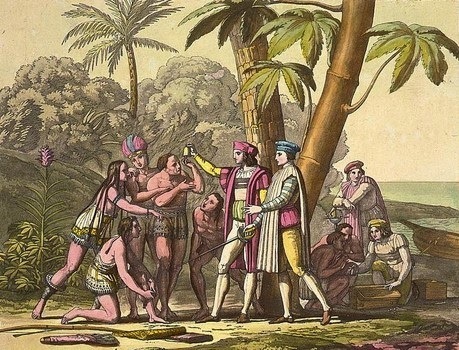
In researching the origins of zombies for a work in progress, I ran across an interesting assertion that this tradition doesn't come from African slaves, as is oft-cited. The premise is that beliefs among the local Taino people are, in fact, the impetus for the belief in dead persons who can be revived and controlled through sorcery. The primary source for this argument is the chronicle of Fray Ramon Pane, a Catholic priest in Columbus' retinue on the island of Hispaniola. In reading through his writings, I have found the following observations of Pane's that might illustrate this point.
"They believe that the dead appear on the roads to those who walk alone, but when many go together, they do not appear."
"They believe the dead go to a place called Coaybay on the side of an island called Soraya."
"When a person is alive, they call his spirit goeiz; when he is dead, opia*"
"There are certain men among them, called bohutis [who claim] they speak with the dead"
"How the dead man's relatives avenge themselves when they have had a reply through the sorcery of the potions. The dead man's relations assemble on a certain day and lie in wait for the said buhuitihu, give him such a thrashing that they break his legs, arms, and head, and leave him for dead. At night, they say, there come many different kinds of snakes--white, black, green, and many other colors--that lick the face and whole body of the physician whom the Indians have left for dead. This they do two or three nights in succession; and presently, they say, the bones of his body knit together again and mend. And he rises and walks rather slowly to his home. Those who meet him on the road say, "Were you not dead?" He replies that the cemies [totems or idols representing deities] came to his aid in the shape of snakes. And the dead man's relations, very angry and desperate because they thought they had avenged the death of their kinsman, again try to lay hands on him; and if they catch him a second time, they pluck out his eyes and smash his testicles, for they say no amount of beating will kill one of these physicians if they do not first tear out his testicles. "
-- Fray Ramon Pane, Hieronymite Monk in the company of Cristopher Columbus, writing about the Taino people on the island of Hispaniola, c. 1498.
* From which the modern Caribbean term for spirits, obeah, is derived. Variations (hupia, et al) can be found throughout the Caribbean, all tracing their origins to Taino culture.
Published on April 01, 2015 19:26
March 28, 2015
Haunted Hellfire Club

In 1725, atop Montpelier hill near Dublin, a wealthy Irishman named William Connolly built a hunting lodge over a burial mound. In fact, legend has it that some of the stones from the cairn were incorporated into the building of the lodge.
It hadn't stood long before a fierce wind ripped the roof off. Locals weren't surprised, seeing the event as a sign of some sort of otherworldly vengeance. Connolly died less than four years later.
The lodge then moved into the hands of Richard Parsons, a man some believe helped bring the infamous Hellfire Club to Ireland. At Hellfire Club meetings, one chair was always left vacant for the devil, according to legends.
Local myth had it that a nearby farmer went poking around, peering into windows at the lodge to learn more about what was going on inside. He was found the next day, suddenly deaf and mute. Other legends speak of a large black cat with horns and 'eyes of the devil'.
The Hellfire Club members were well-off and learned men who chose to frolic in a more debauched atmosphere than most gentlemen's clubs of the time offered. Following a trend then of counter-culture blasphemy, the organization's head was the devil and they often considered themselves devils, but this seemed more of a joke, a way to shock genteel society. Still, legends of the rich and powerful--and their abuses--are endless, so it's no surprise that tales of mayhem and murder abound here. Many believe vengeful victims still stalk the property, demanding retribution from beyond the grave.
Published on March 28, 2015 06:52




